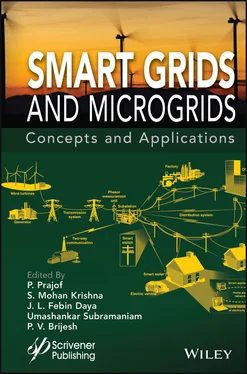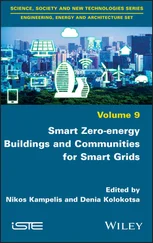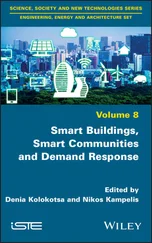Umashankar Subramaniam - Smart Grids and Micro-Grids
Здесь есть возможность читать онлайн «Umashankar Subramaniam - Smart Grids and Micro-Grids» — ознакомительный отрывок электронной книги совершенно бесплатно, а после прочтения отрывка купить полную версию. В некоторых случаях можно слушать аудио, скачать через торрент в формате fb2 и присутствует краткое содержание. Жанр: unrecognised, на английском языке. Описание произведения, (предисловие) а так же отзывы посетителей доступны на портале библиотеки ЛибКат.
- Название:Smart Grids and Micro-Grids
- Автор:
- Жанр:
- Год:неизвестен
- ISBN:нет данных
- Рейтинг книги:5 / 5. Голосов: 1
-
Избранное:Добавить в избранное
- Отзывы:
-
Ваша оценка:
- 100
- 1
- 2
- 3
- 4
- 5
Smart Grids and Micro-Grids: краткое содержание, описание и аннотация
Предлагаем к чтению аннотацию, описание, краткое содержание или предисловие (зависит от того, что написал сам автор книги «Smart Grids and Micro-Grids»). Если вы не нашли необходимую информацию о книге — напишите в комментариях, мы постараемся отыскать её.
Written and edited by a team of experts in the field, this is the most comprehensive and up-to-date study of smart grids and microgrids for engineers, scientists, students, and other professionals.
Audience:
Smart Grids and Micro-Grids — читать онлайн ознакомительный отрывок
Ниже представлен текст книги, разбитый по страницам. Система сохранения места последней прочитанной страницы, позволяет с удобством читать онлайн бесплатно книгу «Smart Grids and Micro-Grids», без необходимости каждый раз заново искать на чём Вы остановились. Поставьте закладку, и сможете в любой момент перейти на страницу, на которой закончили чтение.
Интервал:
Закладка:
Library of Congress Cataloging-in-Publication Data
ISBN 9781119760559
Cover image: Wikimedia Commons
Cover design by Russell Richardson
Set in size of 11pt and Minion Pro by Manila Typesetting Company, Makati, Philippines
Printed in the USA
10 9 8 7 6 5 4 3 2 1
Preface
As the world is getting smarter and smarter, the advancements in digital and information technology are paving the way for advancement in the way electricity is managed and controlled, leading to a more resilient, responsive, and efficient power system known as the smart grid. Making the grid smarter is made possible by adding a layer of technologies, including data-producing sensors, advanced data analytics and smart meters that give energy managers the greater clarity and comprehension they need to make the power system optimally efficient.
The major benefit of the intelligent grid is its ability to let energy providers fine-tune exactly where and when power is needed, and on consumers, it reduces energy consumption and saves money. In the future, it is expected that there will be minimum energy loss, no blackouts and no unexpected spikes in demand due to smart grid. The smart grid in near future will also embrace energy sources that will reduce the amount of greenhouse gases entering into the atmosphere.
Microgrids, on the other hand let customers put sources of energy generation, storage and control on their sites and in their communities to meet between 80 and 100 percent of their average power needs. Microgrids give communities, businesses and public institutions greater energy resilience, reliability, security, and choice about the amount of renewable energy they want to incorporate into their power systems.
The research and development of smart grids and microgrids in the last decades is the way how some countries have modernized their transmission and distribution networks in order to respond to the challenges and problems that the grid has to face, such as the increasing demand or the higher penetration levels of renewable energy resources while keeping high-quality standards in an efficient, reliable, safe, economical and robust manner. The need for gathering information from suppliers and consumers is critical to determine the state of the grid and to optimize the operation and management of the system regarding load shedding, storage administration, and strategies to face faults and grid contingencies.
In this book, we strive to include a rich range of recent developments in smart grids and microgrids. We assume that the book would be a valuable tool for a wide audience, including researchers on smart-grids and microgrids. The major topic covered includes the role of renewable energy sources and storage units in microgrids and smart grids, control and stability analysis of microgrids, the impact of electric vehicles in microgrids and smart grids, role of telecommunication technologies in microgrids and smart grids, IoT, machine learning and artificial intelligence for smart grids and environmental and techno-economic aspects of microgrids and smart grids.
1
A Comprehensive Analysis of Numerical Techniques for Estimation of Solar PV Parameters Under Dynamic Environmental Condition
Balasubramonian M1*, Rajeswari Ramachandran2, Veerapandiyan Veerasamy3, Albert Paul Arunkumar C P2 and Noor Izzri Abdul Wahab3
1 Department of Electrical Engineering, Alagappa Chettiar Government College of Engineering and Technology, Karaikudi, India
2 Department of Electrical Engineering, Government College of Technology, Coimbatore, India
3 Advanced Lightning, Power and Energy Research (ALPER), Department of Electrical and Electronics Engineering, Faculty of Engineering, Universiti Putra Malaysia (UPM), Selangor, Malaysia
Abstract
The ampleness and non-polluting nature of power generation from solar photovoltaic (SPV) is used worldwide to meet the ever-increasing load demand.In order to operate SPV efficiently, an accurate modeling and control is required prior to the installation. Therefore, this chapter presents the Single Diode Model(SDM) of SPV module through which five parameters such as series resistance (R se), shunt resistance (R sh), diode ideality factor (A), light generated current (I LG), diode reverse saturation current (I sat) are determined for extracting the maximum power from PV panel. Initially, this work describes the mathematical model of SPV in terms of the above specified unknown parameters. Using these modeling equations, the parameters are determined under standard test condition (STC). The manipulated form of SPV modeling equations under dynamic environmental condition are portrayed which are used for determining the parameters of SDM. From these parameters, the voltage and current at maximum power point (MPP) are deduced under varying environmental conditions. This study presents the numerical iterative techniques like Gauss-Seidel (GS) and Newton Raphson (NR) approach to solve the non-linear transcendental equations describing the behavior of SPV. The effectiveness of the presented method is tested with various SPV modules such as KD245GX, U5-80, and Shell SP70. The comparative analysis of results obtained reveal that among the presented numerical techniques, the NR method is simple to use, reduces the computational cost and robust. Further, the accuracy of the presented NR method is validated with the results obtained from the experimental data under dynamic environmental conditions. The comparison of I-V and P-V characteristics of HST60FXXXP PV panel from experimental results and numerical analysis shows unnoticeable deviation between them. The predicted values of MPP voltage and current estimated from numerical techniques under dynamic environmental conditions are in good agreement with experimental results.
Keywords: Solar PV parameter estimation, single diode model, maximum power point, Newton-Raphson, Gauss-Seidel
Nomenclature
| SPV | Solar Photo Voltaic |
| RE | Renewable Energy |
| MG | Microgrid |
| MPP | Maximum Power Point |
| STC | Standard Test Conditions: Solar Irradiance 1000W/m 2and Cell temperature 25±2°C |
| GS | Gauss-Seidel |
| NR | Newton Raphson |
| SDM | Single Diode Model |
| SCC | Short Circuit Condition |
| OCC | Open Circuit Condition |
| SUR | Successive Under Relaxation |
| V mpp | Voltage at the maximum power point |
| I mpp | Current at the maximum power point |
| V oc | Open circuit voltage |
| I sc | Short circuit current |
| ki | Temperature co-efficient for SC current |
| kv | Temperature co-efficient for OC voltage |
| G | Irradiance in W/m 2 |
| T | Temperature in Kelvin |
1.1 Introduction
In recent years, the raise in energy crisis and environmental pollution makes the world move towards ‘Go Green’ technology called renewable power generation. The electric power generation from RE (Renewable Energy) sources has been tremendously increasing owing to their advantages of the eco-friendly and inexhaustible resource, which reduces global warming and environmental pollution caused by conventional generating sources and facilitates easy availability with minimum distribution loss, etc. [1, 2]. Among various RE (Renewable Energy) sources such as SPV, wind, biomass, and other sources, the power generation from a SPV source is more promising due to its large quantity in nature, its low cost, its lower weight, and its flexibility. Moreover, it is one of the major RE generations opted in a majority of the countries as either base load or peak load power generation by combining with other RE sources and storage technologies such as hybrid Microgrid (MG) source or integrating into the power grid [3, 4]. Due to the development of modern inverters equipped with maximum power point tracking (MPPT) and energy storage system helps the stand-alone SPV Microgrid system to supply reliable electrical energy in remote areas and also for rural electrification. One of the major challenges in solar PV is to track the maximum power (i.e. maximum voltage and current) from the solar PV production under dynamic environmental conditions such as varying temperature, irradiation, partial shading, and environmental pollution on the panel [5, 6]. Since the performance of solar PV generation system affects the power quality, reliability, security, and stability of MG under varying environmental conditions, it is necessary to improve the efficiency of the PV panel. To achieve this efficiency, an accurate mathematical model for estimating the maximum voltage and current under dynamic environmental conditions is required. The proper design and control of SPV module improves the efficiency and makes the SPV system as economically feasible. This leads to assess the payback period of SPV generation system for economic investment [7, 8].
Читать дальшеИнтервал:
Закладка:
Похожие книги на «Smart Grids and Micro-Grids»
Представляем Вашему вниманию похожие книги на «Smart Grids and Micro-Grids» списком для выбора. Мы отобрали схожую по названию и смыслу литературу в надежде предоставить читателям больше вариантов отыскать новые, интересные, ещё непрочитанные произведения.
Обсуждение, отзывы о книге «Smart Grids and Micro-Grids» и просто собственные мнения читателей. Оставьте ваши комментарии, напишите, что Вы думаете о произведении, его смысле или главных героях. Укажите что конкретно понравилось, а что нет, и почему Вы так считаете.












